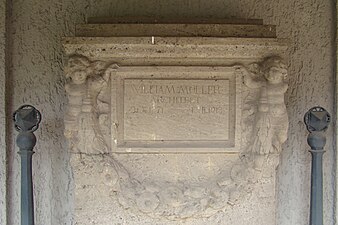William Müller (architect)

William Müller (born October 31, 1871 in Großenhain ; † February 12, 1913 in Braunlage ) was a German architect .
life and work
Müller studied at the teaching institute of the Kunstgewerbemuseum Berlin as a student of Alfred Messel and also worked as an employee of Otto Rieth and Ludwig Hoffmann .
In 1901/1902 Müller took part in the competition for the Hamburg Bismarck Memorial , in which he - even before his former boss Otto Rieth - came in second. Müller's design showed a resting lion at the end of a massive observation tower and was shown as a model at the St. Louis World Exhibition in 1904 .
From 1904 he was co-editor of the magazine Der Baumeister and taught at the arts and crafts school in Berlin-Charlottenburg . He also merged with the architects Johann Emil Schaudt and Max Salzmann as well as painters and sculptors to form the Neue Gruppe Berlin , which organized an elaborate art exhibition in the same year
In 1906, one year after Max Reinhardt took over the Deutsches Theater (DT) in Berlin , Müller commissioned him to build the Kammerspiele in the neoclassical style as an additional venue. Edvard Munch's frieze of life hung in the lobby . 1908/1909 the Villa Agnesstrasse 1 was built for the entrepreneur Oscar Troplowitz in Hamburg . In 1909, upon invitation, Müller took part in a limited competition for the new building of the Bremerhaven City Theater . The other participants were Max Littmann , Martin Dülfer and Oskar Kaufmann , who finally carried out the construction.
From 1909 to 1910, Müller built the first Berlin crematorium on the urn cemetery on Richtstrasse in the Wedding district, with a celebration hall, burial rooms and columbarium . The center of the complex is a mighty octagonal central building in the neoclassical style. Müller's own grave was located in the portico next to the entrance to the celebration hall.
1913–1915, Hermann Jansen , a former colleague of Müller, expanded the crematorium with wings and rear farm buildings after his unexpected early death.
- Grave monument / grave site William Müller at the crematorium Berlin-Wedding
Buildings and designs
- 1904: Marble bathroom at the art exhibition of the "Neue Gruppe Berlin"
- 1906: Conversion of a casino to the Kammerspiele of the German Theater in Berlin
- 1908–1909: Villa for Oscar Troplowitz in Hamburg, Agnesstrasse 1
- 1909–1910: Crematorium in Berlin-Wedding ,gerichtstrasse 37/38
- 1909–1910: Crematorium in Dessau
- 1910: Competition draft for a Bismarck national monument on the Elisenhöhe near Bingerbrück (not awarded a prize)
- 1911: Design for a renovation of the “Breidenbacher Hof” hotel in Düsseldorf
- before 1912: House renovation for Prince Hatzfeld in Berlin
- before 1912: Residence for government councilor Dr. Moll in Berlin-Zehlendorf
- before 1912: Hunting lodge for Fritz von Friedlaender-Fuld in Groß-Gorschütz (Upper Silesia)
- before 1912: Office and commercial building of the Julius Springer publishing house in Berlin, Linkstrasse 23/24
- before 1912: Zossener Bridge over the Landwehr Canal in Berlin-Kreuzberg, between Zossener Strasse and Alte Jakobstrasse
- before 1912: Hunting lodge for Prince Adolf zu Hohenlohe-Ingelfingen near Koschentin
- before 1912: Hall for Prince Lichnowsky in Kuchelna Castle
- before 1912: Hall in Walburg Castle
- before 1913: country house for general manager Wachsmann on Emmagrube (Upper Silesia)
- before 1913: Kannengießer tomb in Prenzlau
literature
- Müller, William . In: Hans Vollmer (Hrsg.): General lexicon of fine artists from antiquity to the present . Founded by Ulrich Thieme and Felix Becker . tape 25 : Moehring – Olivié . EA Seemann, Leipzig 1931, p. 249 .
Web links
Individual evidence
- ↑ a b c Entry in the Berlin State Monument List for the Deutsches Theater and the Kammerspiele
- ↑ Jörg Schilling: “ Keeping your distance”. The Hamburg Bismarck Monument and the monumentality of modernity. Wallstein-Verlag, Göttingen 2006, ISBN 3-8353-0006-7 , p. 180, footnote 300.
- ↑ Jörg Schilling: “ Keeping your distance”. The Hamburg Bismarck Monument and the monumentality of modernity. Wallstein-Verlag, Göttingen 2006, ISBN 3-8353-0006-7 , p. 279, footnote 15.
- ^ A b Hermann Lüer : New Group Berlin. In: Berliner Architekturwelt . 6th year 1903/1904, issue 6 (from September 1903), pp. 197-200.
- ↑ Nikolaus Bernau: Where did Munch's life frieze hang? About the construction of the Kammerspiele and their most famous jewelry. In: Roland Koberg, Bernd Stegemann, Henrike Thomsen (eds.): Blätter des Deutschen Theater. Max Reinhard and the German Theater. Berlin 2005, pp. 65-78.
- ^ Antje Hansen: Oskar Kaufmann. A theater architect between tradition and modernity. Gebr. Mann Verlag, Berlin 2001, ISBN 3-7861-2375-6 , pp. 27-28.
- ↑ a b c Entry in the Berlin State Monument List for the crematorium at the Wedding urn cemetery
- ↑ a b c d e f g h i j k l m The builder. 10th year 1912, No. 1.
- ↑ German construction newspaper . 45th year 1911, No. 53 .
- ↑ Max Schmid (ed.): One hundred designs from the competition for the Bismarck National Monument on the Elisenhöhe near Bingerbrück-Bingen. Düsseldorfer Verlagsanstalt, Düsseldorf 1911. (n. Pag.)
- ↑ a b c d lecture at the Schinkel Festival of the Architects' Association in Berlin. ( Memento of the original from March 16, 2014 in the Internet Archive ) Info: The archive link was inserted automatically and has not yet been checked. Please check the original and archive link according to the instructions and then remove this notice. accessed on March 17, 2014.
| personal data | |
|---|---|
| SURNAME | Müller, William |
| BRIEF DESCRIPTION | German architect |
| DATE OF BIRTH | October 31, 1871 |
| PLACE OF BIRTH | Grossenhain |
| DATE OF DEATH | February 12, 1913 |
| Place of death | Braunlage |





